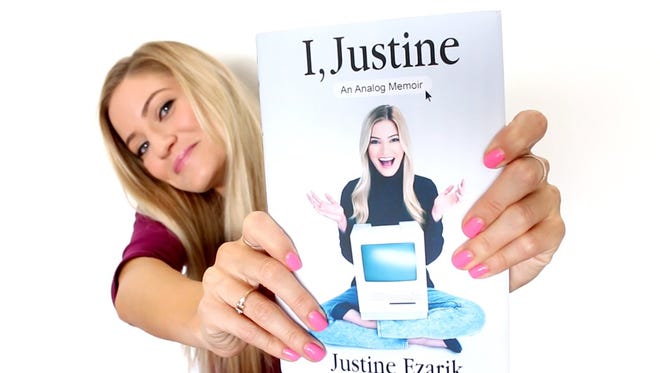How to make money on Youtube

Have a tween or teen in your home? Chances are they follow a handful of YouTube stars – and a good number of them would love to be one, too. Don’t be so surprised this is a “thing.” Popular YouTube personalities can enjoy considerable fame and fortune.
According to Forbes, the 12 top YouTube celebs raked in a combined $70.5 million over 12 months ending in June 2016, with PewDiePie (real name: Felix Kjellberg), a Swedish gamer and jokester, earning top spot at $15 million. Even if you’re not in this esteemed list, you could be making a very comfortable living.
Just ask Justine Ezarik (a.k.a. iJustine), an L.A.-based creator with 3.7 million YouTube subscribers on her channel, and with more than 630 million views on her videos. “Essentially, I’m a content creator who gets to talk about everything that I love – namely, cooking, tech, travel, and video games,” explains Ezarik in a telephone interview with USA TODAY. “YouTube is an extension of myself.”
Related:
5-year-old threatens to dethrone YouTube king PewDiePie
YouTube takes on Facebook with mobile live
Rhett and Link - fans now get YouTube Red
Ezarik’s first passion was editing, says the 33-year-old, but recalls “no one wanted to be in my videos, and so I put myself in them to give me something to edit. Then people wanted more.”
Ezarik declined to comment on how much she makes from YouTube.
Creating a successful channel
There are a few different ways to make money once your YouTube channel is successful. Here’s how to get going:
Step 1: Figure out your ‘thing’
Fancy becoming a YouTuber? You first need to figure out your passion – whether it’s gadgets, celebrity gossip, religion, politics, pets, make-up, and so on. “The most important thing is find out what you want make videos about, and have fun,” says Ezarik. “It’s also ideal if you’re doing something unique, some niche content, you can become the best at.” Create a free YouTube channel. Sign up for AdSense to monetize your videos (see below).
Step 2: Get your gear
You don’t need expensive hardware to get going. Content is far more important than having 4K or 360-degree video. Great quality helps, but today’s smartphones are more than good enough to start with. That said, good lighting is very important: natural is great, if you can be outdoors, or near a window, or pick up some lighting kits that start at a couple of hundred dollars. Clear audio is critical, too; you can buy a highly-rated clip-on lavalier (“lav”) mic starting at only $23.
Step 3: Upload a lot
Flesh out your topics and start creating fresh content on a regular basis. Just tap record on the camera, and talk. Be natural. You’ll also get better at hosting these segments as time goes on. If your videos require other people and/or editing, find some friends who can help pro bono. With videos ranging from five to 35 minutes, Ezarik says she spends more time editing than shooting, but is starting to enlist some help to free up her time.
Step 4: Manage, promote your channel
Remind your YouTube viewers to subscribe to your channel, during or after the video plays, and in the description or comments section. Tag your videos with relevant keywords, so people can find your work. Push traffic to your YouTube channel from other social platforms. “Boosting your subscribers won’t happen overnight, but keep it up. Consistency is key, and you can reach out to other creators for advice or collaboration,” adds Ezarik (YouTube says collaboration is critical, too). Interact with your viewers by responding to comments.
Related:
YouTube: A parent's guide to watching, hosting videos
There are three main ways a popular YouTuber can make money:
From YouTube:
The main revenue stream is often allowing YouTube to run ads with your content. The more traffic you get, the more you can make, says Ezarik. There are many variables that could determine how much you’ll get (and YouTube recently changed it so you need at least 10,000 lifetime views to start making money). Once you enable your channel for monetization, you’ll connect your YouTube channel to a Google AdSense account to earn money for your monetized videos.
Note: you cannot be paid if there is copyrighted material in your video.
From sponsors:
Ezarik and many other YouTube stars are often paid as a brand “ambassador” or “influencer.” After all, if a popular YouTube personality has direct access to millions of fans — who could watch their videos anywhere, anytime, and on a multitude of devices — a sponsorship or endorsement arrangement could be smart for companies big and small. And it could be extremely lucrative for the YouTuber, too. With TV viewership on the decline, millennials are turning to YouTube in big numbers. YouTubers can be creative on how they integrate products or services into their videos. Ezarik has worked with major brands including Mattel, Microsoft, Ford, GE, Intel, Sharpie, Doritos, Taco Bell, eBay, P&G, Banana Republic, Samsung, AOL, and Carl’s Jr.
From fans:

As “iJustine,” Ezarik has broadened her brand outside of YouTube. She often hosts or emcees live events around the world. She’s written a book, I, Justine: An Analog Memoir (2015), and has dabbled in merchandise, mobile apps (yes, more than one), and has starred in TV commercials. Ezarik says YouTube creators could also engage YouTube’s “Super Chats,” announced in May, where fans can pay small amounts to interact with YouTubers during live streams. “Fan funding is fairly new, but these donations are another way you can make money,” says Ezarik.
Follow Marc on Twitter: @marc_saltzman. E-mail him at askmarcsaltzman@gmail.com.
![iJustine [image : 102397484]](/gcdn/-mm-/97da3cfa1aa792a6deb5f9f99bfc1f18d3372b83/c=461-0-1541-923/local/-/media/2017/06/01/USATODAY/USATODAY/636319295662892148-iJustine---YouTube.png?width=660&disable=upscale&format=pjpg&auto=webp)